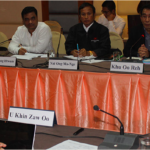By Lu Min Mang/ The Myanmar Times | October 3, 2016
A girl as young as two years old was killed and two other children were injured when an artillery shell struck near their homes on the morning of October 1, as fighting has intensified in recent weeks in northern Shan state.
Mangshang Zung Myaw died of a shrapnel wound in Pu Wang village, Mong Ko town, while six-year-old Lagwi Bom Lang sustained severe injuries to the abdomen and five-year-old Lagwi Ting Kyang was struck in the thigh, said U San Aung, a member of the Peace Creation Group. The strike took place near the Chinese border in Muse township.
“One passed away a few minutes after being hit by a bomb fragment and the other two seriously injured were then sent to hospital,” said U San Aung, whose group was created to facilitate peace negotiations between the Kachin Independence Army and the Tatmadaw.
Fighting between government troops and the KIA has been ongoing over the course of the last month. Yesterday, however, the battlefield was silent, according to Lieutenant Colonel Naw Bu, a KIA communications officer.
Local villagers believe the shell that killed Mangsheng Zung Myaw was fired by the Tatmadaw.
“I think that is true, based on our on-the-ground information,” Lt Col Naw Bu said of the incident.
Fighting between the Tatmadaw and the KIA in Kachin and northern Shan states erupted in mid-August and persisted intermittently throughout September.
According to Lt Col Naw Bu, the latest clashes took place on October 1, when Battalion No 36 of the KIA’s Brigade 6 exchanged fire with Tatmadaw soldiers. He could not provide figures on casualties.
“The fighting has intensified since the middle of September. The Tatmadaw is using military aircraft and armed forces. Fierce fighting occurred in N’Hkam Bum, a securitised zone for the KIA’s headquarters at Laiza,” he said.
“At least 10 times fire was exchanged in N’Hkam Bum,” he added.
In addition to Tatmadaw air and ground forces, U San Aung said the battlefield has seen new actors enter the fray.
“We have evidence of the presence of local militias” cooperating with the Tatmadaw in battle against the KIA, U San Aung said.
He said he had obtained an official letter sent to a local militia group requesting that it supply troops in the Tatmadaw’s conflict with the KIA.
U San Aung said the Peace Creation Group sent a letter to State Counsellor Daw Aung San Suu Kyi on September 23, calling for an end to military offensives in ethnic areas, particularly against the KIA. However, the group’s call for de-escalation has not yet received an official response from the state counsellor, her office or the National Reconciliation and Peace Center.
No official figures on civilian displacement due to the latest fighting in the Kachin and Shan states have been made available.
Daw Aung San Suu Kyi is chair of the National Reconciliation and Peace Center, a leading organ in ongoing peace talks between the government and ethnic armed organisations. She is also chair of the Union Peace Dialogue Joint Committee, a tripartite committee consisting of government – executives, legislative and Tatmadaw representatives – political parties and ethnic armed organisations that is laying the groundwork for future political dialogue.
The state counsellor does not, however, exert civilian control over the military.
The Peace Creation Group was formed to assist with conflict abatement through a disputes resolution mechanism. U San Aung said the mechanism is not working currently because stakeholders were more interested in presenting complaints rather than finding mutually agreeable solutions.
“The meetings have become a place where they present their problems. It is no longer about resolving the conflicts among them,” he said.
The latest fighting between the KIA and the Tatmadaw has also raised concerns about the broader implications for Myanmar’s peace process. The ethnic Kachin armed group is an influential and leading member of the United Nationalities Federal Council, a bloc of seven ethnic armed groups that have not yet signed the so-called nationwide ceasefire agreement.
Lt Col Naw Bu questioned the intentions of the military establishment.
“I think it shows that they are not so eager to have peace talks with us,” he said.
U San Aung insisted that the fighting was tied to the 21st-century Panglong Conference that concluded last month, and ethnic armed groups’ repeated calls for constitutional reform over the course of the four-day event.
“While most of the participants who delivered their messages at the conference expressed that they were willing to amend the constitution, the Tatmadaw was the one that was not calling for constitutional amendment. I think they have that concern and that’s why – escalation is a solution,” he said.
This article originally appeared on The Myanmar Times on October 3, 2016.







[…] caught up in the crossfire, resulting in massive displacement throughout the country and a needless loss of life. Meanwhile, the continuing state-led persecution of the Rohingya and other religious minorities has […]